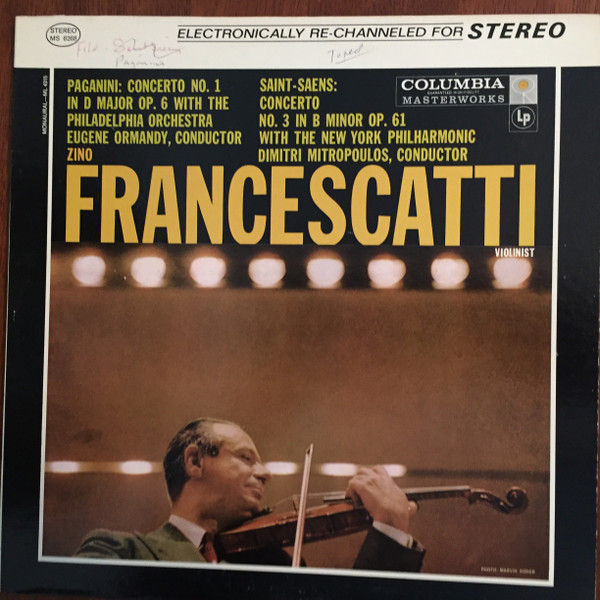SEPTEMBER 22, 2024 – I remember well the record jacket: it featured the head, shoulders and left hand of a smiling gentleman performing the violin. A row of stage lights burned brightly above him. In big gold capital letters above the image on the jacket was the man’s last name, “FRANCESCATTI.” In much smaller letters over the F and the R was his first name, “Zino.” The LP featured the French violinist’s recording of the Paganini Violin Concerto No. 1 in D with the Philadelphia Orchestra under Eugene Ormandy, and the Saint-Saëns Violin Concerto No. 3 in b minor with the New York Phil conducted by Dmitri Mitropoulos.
While my sister Elsa was studying the Saint-Saëns, the record got a regular workout, which is why I became so familiar with the record jacket. “Zino Francescatti” was otherwise a household name—in our household, anyway—along with everyone’s favorite, Jascha Heifetz, and a long slate of other famous 20th century violinists. “Francescatti” was my favorite to pronounce, however, mainly because it was preceded by “Zino,” which I thought was a cool name. Only more recently did I learn that early in his career he’d adopted “Zino” as a stage name; his real name was “René-Charles.”
His name and nationality threw me. He was French, I was told, which was easy to remember, since “France” was built into “Francescatti,” but the “scatti” part was obviously Italian. In fact, he was born in Marseilles, but though his mother was French, his father, Fortunato, was Italian. Both parents were professional violinists, and they were the only teachers that “Zino” ever had. His father had studied with Camillo Sivori, who, in turn, had been a student of Niccolò Paganini, one of the leading virtuosi of the day and composer of a whole stable of famous war horses: six concerti (the first being the most popular by far) and the virtuosic herd of 24 caprices. For violinists, Francescatti’s connection to Paganini is hot stuff.
Of course, our family and our Nilsson grandparents had to find our way to Northrop Auditorium at the U of M when the rock star Francescatti came to Minneapolis to play with the then Minneapolis Symphony (now Minnesota Orchestra) under the baton of Stanisław Skrowaczewski. I wish I could remember which concerto Francescatti performed. I remember being impressed, however, that I was seeing and hearing on stage, a guy who had his picture and all-caps name on a Columbia Records album jacket.
As I write this today, I couldn’t tell you what was so special about Francescatti’s playing back when I was a kid. All I know is that I often heard his name, along with his recording of the Saint-Saëns as I raced through the living room. And there was the live performance, of course, but again, I was too young to know really what extraordinary violin-playing was filling the auditorium—and our living room.
More recently, I’ve listened to his full recording of . . . Saint-Saëns’ most familiar concerto (No. 3) and the Beethoven. I have to agree that Francescatti had a sweet, lyrical sound and that he was most worthy of his supreme reputation. On YouTube I found a video of his 1973 performance of the Beethoven with the Netherland Radio Philharmonic directed by Jean Fournet. It was filmed over half a century ago, mind you, when Francescatti was 71 years old (he’d first performed it for his debut at age 10), and I was amused by the hair and clothing styles among the audience (and hair among the women orchestra members—and that there were, in fact, women members (rare in orchestras of that era)). Among the attentive concert-goers was a kid about my age when I heard Francescatti that night in Minneapolis a good 60 years ago. I wondered what that kid’s background was; and assuming he’s alive today, if he could tell us about the concert.
For all our grousing as Boomers, including our disparagement of “social media” (though we ourselves are plenty addicted to it), I say, the “internet is a beautiful thing,” and its content—particularly videos and remastered recordings of the greatest violinists of the 20th century—is enriching beyond measure.
Saint-Saëns, who lived well into the 20th century, might not be as astonished by recordings accessible online (once he grasped the totality of “online”). But Beethoven? Once he got over the complete shock of hearing a recording (especially with his hearing restored) and seeing a video, would’ve approved wholeheartedly, Zino Francescatti’s rendition.
By the year of his performance of the Beethoven with NRP, Francescatti had curtailed his international concertizing. The next year, at age 72, he observed, “To play an instrument with a bow and to keep the sound beautiful is so difficult after 70.” It was too bad that Isaac Stern didn’t follow Francescatti’s implicit advice and retire from the concert stage before Stern’s playing deteriorated to the point of embarrassment.
Francescatti lived well beyond the age when “playing an instrument with a bow” became difficult. In 1991 died at 89 at his home in La Ciotat, France on the Mediterranean Sea.
Subscribe to this blog and receive notifications of new posts by email.
© 2024 by Eric Nilsson

2 Comments
Was there some kind of conflict between Francescatti and Stern?
I’m not sure; Richard; I’ve never heard that there was, but among accomplished artists, not to mention other high achievers, rivalries are not uncommon.